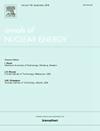Doppler effect evaluation of the TRU-based Moroccan TRIGA Mark II reactor: Applying novel methodologies
IF 1.9
3区 工程技术
Q1 NUCLEAR SCIENCE & TECHNOLOGY
引用次数: 0
Abstract
The Doppler effect, commonly referred to as fuel temperature coefficient (), is a critical parameter that quantifies the reactivity feedback resulting from changes in fuel temperature. Understanding and accurately quantifying is essential for evaluating and adopting innovative fuel compositions. In this study, we present a comprehensive evaluation of for transuranic (TRU)-based Moroccan TRIGA Mark II reactor, employing advanced simulation techniques and methodologies based on the OpenMC code. Two novel methods are introduced and validated. The first method analyzes the contributions of the fast fission factor (), resonance escape probability factor (), thermal utilization factor (), and reproduction factor () to . The second evaluates the Upscattering and isotope-wise contributions to gain deeper insights into the behavior of these factors. Additionally, is evaluated as a function of fuel burnup. For comparative purposes, the standard U-ZrH1.65 fuel is also analyzed to benchmark the behavior of the TRU-based fuel against conventional fuel types.
The results reveal that TRU-based fuel, despite its high fissile content, it maintains a negative across the operational temperature range and throughout the reactor’s lifetime. This negative reactivity feedback is attributed to the significant thermal capture resonances of TRU-based isotopes, such 240Pu, and 242Pu, and the unique properties of the zirconium hydride matrix ZrH1.65. Although the magnitude of for TRU-based fuel is less negative compared to the standard U-ZrH1.65 fuel, it remains sufficiently negative to guarantee safe reactor operation.
These findings are promising and suggest that further exploration of TRU-based fuels could support the development of reliable, clean, and sustainable nuclear energy systems.
求助全文
约1分钟内获得全文
求助全文
来源期刊

Annals of Nuclear Energy
工程技术-核科学技术
CiteScore
4.30
自引率
21.10%
发文量
632
审稿时长
7.3 months
期刊介绍:
Annals of Nuclear Energy provides an international medium for the communication of original research, ideas and developments in all areas of the field of nuclear energy science and technology. Its scope embraces nuclear fuel reserves, fuel cycles and cost, materials, processing, system and component technology (fission only), design and optimization, direct conversion of nuclear energy sources, environmental control, reactor physics, heat transfer and fluid dynamics, structural analysis, fuel management, future developments, nuclear fuel and safety, nuclear aerosol, neutron physics, computer technology (both software and hardware), risk assessment, radioactive waste disposal and reactor thermal hydraulics. Papers submitted to Annals need to demonstrate a clear link to nuclear power generation/nuclear engineering. Papers which deal with pure nuclear physics, pure health physics, imaging, or attenuation and shielding properties of concretes and various geological materials are not within the scope of the journal. Also, papers that deal with policy or economics are not within the scope of the journal.
 求助内容:
求助内容: 应助结果提醒方式:
应助结果提醒方式:


